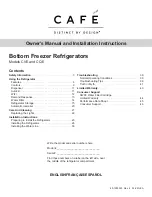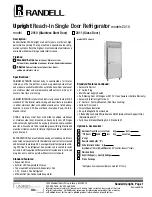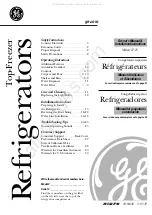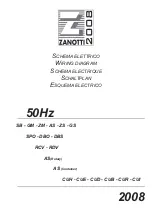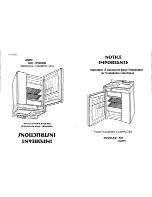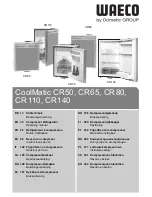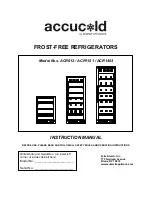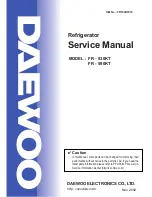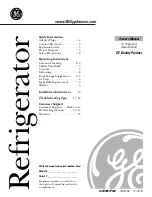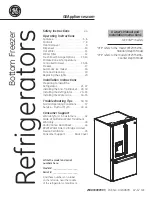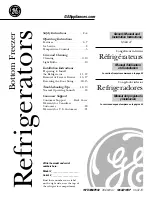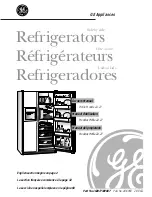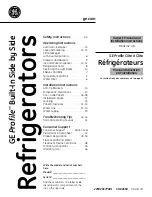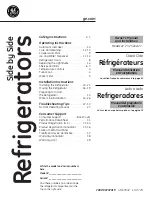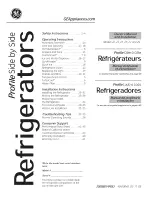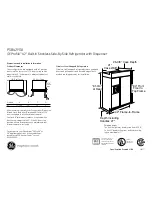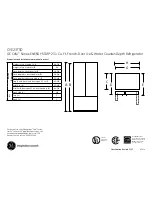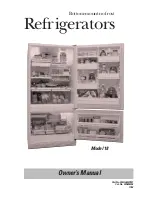
7
8
HOW TO OPERATE
Before first use, remove all adhesive tape from the drawers, shelves, trays and drain tube plug.
INSTALLATION
1.
The refrigerator should be placed on a completely flat surface. Allow 1 foot of space on each
side of the refrigerator and between the refrigerator and the wall. Also allow at least 8
inches of space between the top of the refrigerator and the ceiling.
2.
Choose a location for your refrigerator that is not exposed to sunlight, high temperature or
humidity, as humidity may stain and damage the refrigerator.
3.
The appliance can be adjusted by rolling the two legs in the bottom front of the refrigerator
if it becomes unstable. Raise the refrigerator by rolling the two legs clockwise.
4.
The surface of the location where the refrigerator is installed should be firm and flat. If
refrigerator is not secured in a proper location, noise and vibration may occur. The noise
may be increased if the floor is not firm. If you have to position the refrigerator on a
carpeted floor, place a sheet underneath the refrigerator, such as plywood or a plastic mat,
to prevent heat emissions from ruining the carpet.
5.
Make sure that legs are pressed firmly into the floor and allow the refrigerator to lean
backward slightly so that the doors remain closed.
PLACEMENT OF FOOD
1.
There should always be some space between items inside for air circulation.
2.
Food should be kept in sealed containers to avoid becoming dry, spoiled or creating odors
in the refrigerator.
3.
Hot food should be cooled down before placing into the appliance. Otherwise, bacteria will
grow in food.
4.
Reducing the frequency of opening the doors can lower the electronic consumption.
NOTE: Do not use any electronic equipment inside the appliance.
ADJUSTING TEMPERATURE
The temperature of the refrigerator can be controlled manually by the knob. However, the
number shown on the knob does not correlate to the degrees. The higher the number, the
lower the interior temperature of the refrigerator will be.
DEFROSTING
Heavy frost will effect the efficiency and performance of the refrigerator and can create
increased energy consumption. If the frost inside of the freezer gets as thick as ¼ inch, you
must defrost the refrigerator. Follow these steps to defrost the freezer:
1.
Remove all food from the refrigerator and freezer.
2.
Uninstall the drawers and shelves.
3.
Unplug the power supply cord.
4.
Open the doors and wait for the appliance to thaw completely.
5.
Clean up the water with dry towels.
NOTE: DO NOT use any other equipment or method to force the defrost process. It may ruin
the cooling system.
DISCONNECTING THE APPLIANCE
After a power failure the refrigerator can keep food cool for several hours if doors are kept
shut.
If the power fails, do not put additional food into the refrigerator or open the doors.
If you plan to have your power shut off for an extended period of time, make sure to remove
all perishable food from the refrigerator or freezer first.
If you stop use of your refrigerator for an extended period of time, unplug the appliance
from the outlet.
Always wait at least five minutes after unplugging the power supply cord before plugging it
back in.
PACKING AND MOVING
Save packing materials if possible and remember how materials are packed in the box.
Repack refrigerator and accessories carefully.
DO NOT lift or pull the doors or door handles during transportation.
When moving, do not tilt appliance more than 45 degrees. Be very careful not to bump the
refrigerator into anything.
Allow appliance to stand upright for at least 24 hours before plugging into the electrical
outlet.
0 = OFF
1-2 = Higher (warmer) Temperature
3-5 = Normal Use
6-7 = Lower (colder) Temperature
3.1 _CuFt_Refrigerator_Manual.indd 7-8
4/26/19 4:23 PM







